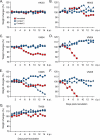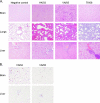Inefficient transmission of H5N1 influenza viruses in a ferret contact model - PubMed (original) (raw)
Comparative Study
. 2007 Jul;81(13):6890-8.
doi: 10.1128/JVI.00170-07. Epub 2007 Apr 25.
Aleksandr S Lipatov, Natalia A Ilyushina, Elena A Govorkova, John Franks, Neziha Yilmaz, Alan Douglas, Alan Hay, Scott Krauss, Jerold E Rehg, Erich Hoffmann, Robert G Webster
Affiliations
- PMID: 17459930
- PMCID: PMC1933302
- DOI: 10.1128/JVI.00170-07
Comparative Study
Inefficient transmission of H5N1 influenza viruses in a ferret contact model
Hui-Ling Yen et al. J Virol. 2007 Jul.
Abstract
The abilities to infect and transmit efficiently among humans are essential for a novel influenza A virus to cause a pandemic. To evaluate the pandemic potential of widely disseminated H5N1 influenza viruses, a ferret contact model using experimental groups comprised of one inoculated ferret and two contact ferrets was used to study the transmissibility of four human H5N1 viruses isolated from 2003 to 2006. The effects of viral pathogenicity and receptor binding specificity (affinity to synthetic sialosaccharides with alpha2,3 or alpha2,6 linkages) on transmissibility were assessed. A/Vietnam/1203/04 and A/Vietnam/JP36-2/05 viruses, which possess "avian-like" alpha2,3-linked sialic acid (SA) receptor specificity, caused neurological symptoms and death in ferrets inoculated with 10(3) 50% tissue culture infectious doses. A/Hong Kong/213/03 and A/Turkey/65-596/06 viruses, which show binding affinity for "human-like" alpha2,6-linked SA receptors in addition to their affinity for alpha2,3-linked SA receptors, caused mild clinical symptoms and were not lethal to the ferrets. No transmission of A/Vietnam/1203/04 or A/Turkey/65-596/06 virus was detected. One contact ferret developed neutralizing antibodies to A/Hong Kong/213/03 but did not exhibit any clinical signs or detectable virus shedding. In two groups, one of two naïve contact ferrets had detectable virus after 6 to 8 days when housed together with the A/Vietnam/JP36-2/05 virus-inoculated ferrets. Infected contact ferrets showed severe clinical signs, although little or no virus was detected in nasal washes. This limited virus shedding explained the absence of secondary transmission from the infected contact ferret to the other naïve ferret that were housed together. Our results suggest that despite their receptor binding affinity, circulating H5N1 viruses retain molecular determinants that restrict their spread among mammalian species.
Figures
FIG. 1.
Phylogenetic tree based on the HA gene (nucleotides 77 to 1200, 1,124 bp) of H5N1 influenza A viruses. The nucleotide sequences were analyzed by Phylip3.65 software using the neighbor-joining method with 100 bootstraps. The tree was rooted to the A/Gs/Guandong/1/96 HA sequence. Viruses in colored bold type were included in this study. Abbreviations: Ck, chicken; Dk, duck; Gs, goose; Qa, quail; JWE, Japanese white eye; WS, whooper swan; BHG, bar-headed goose.
FIG. 2.
Temperature changes and virus titers of human H5N1 influenza viruses in a ferret contact model. Virus titers (log10 TCID50/ml) are shown (<, below detection limit of 101.5 TCID50/ml). Shown are results for one donor ferret (inoculated) and two recipient (contact) ferrets in two independent tests of each virus. (A and B) HK/03 virus; (C and D) VN/04 virus; (E and F) VN/05 virus; (G) TK/06 virus. Overturned ferret figures indicate time of death (d, day), and the yellow stars indicate sites of virus isolation (virus was detected in the nasal turbinate, olfactory bulb, brain, trachea, lungs, and large intestine of an VN/04-inoculated ferret in panel D; virus was detected in the nasal turbinate, olfactory bulb, brain, and large intestine in panel F).
FIG. 3.
Ferret weight changes during H5N1 influenza virus transmission experiments. The changes in ferret weight are shown for one donor ferret (inoculated) and two recipient (contact) ferrets in two independent tests of each virus. (A and B) HK/03 virus; (C and D) VN/04 virus; (E and F) VN/05 virus; (G) TK/06 virus. Daily weight changes (as a percentage) of each ferret were compared to its own initial weight prior to the initiation of the experiments.
FIG. 4.
Virus titers detected in tissues of inoculated ferrets at 5 days postinoculation. Virus in brain, olfactory bulb, nasal turbinate, trachea, lungs, and large intestine was titrated in MDCK cells. Each data point represents the virus titer (log10 TCID50/gram tissue) (mean ± SD) from two ferrets (data for the Wuhan/95 virus were obtained from one ferret).
FIG. 5.
Histopathologic findings in ferrets with H5N1 virus infection. (A) Views of hematoxylin-and-eosin-stained brain, lung, and liver samples of HK/03- and TK/06-inoculated ferrets and a VN/05-infected contact ferret. Uninfected ferret tissues were included as negative controls. Magnification, ×10. (B) Immunohistochemistry detected H5N1 viral antigen in the brain and liver of VN/04-inoculated or VN/05-infected contact ferrets. Magnification, ×20.
Similar articles
- Pathogenesis and Transmission of Novel Highly Pathogenic Avian Influenza H5N2 and H5N8 Viruses in Ferrets and Mice.
Pulit-Penaloza JA, Sun X, Creager HM, Zeng H, Belser JA, Maines TR, Tumpey TM. Pulit-Penaloza JA, et al. J Virol. 2015 Oct;89(20):10286-93. doi: 10.1128/JVI.01438-15. Epub 2015 Jul 29. J Virol. 2015. PMID: 26223637 Free PMC article. - Highly pathogenic avian influenza A(H5N1) virus of clade 2.3.4.4b isolated from a human case in Chile causes fatal disease and transmits between co-housed ferrets.
Pulit-Penaloza JA, Brock N, Belser JA, Sun X, Pappas C, Kieran TJ, Basu Thakur P, Zeng H, Cui D, Frederick J, Fasce R, Tumpey TM, Maines TR. Pulit-Penaloza JA, et al. Emerg Microbes Infect. 2024 Dec;13(1):2332667. doi: 10.1080/22221751.2024.2332667. Epub 2024 Jun 13. Emerg Microbes Infect. 2024. PMID: 38494746 Free PMC article. - Domestic pigs have low susceptibility to H5N1 highly pathogenic avian influenza viruses.
Lipatov AS, Kwon YK, Sarmento LV, Lager KM, Spackman E, Suarez DL, Swayne DE. Lipatov AS, et al. PLoS Pathog. 2008 Jul 11;4(7):e1000102. doi: 10.1371/journal.ppat.1000102. PLoS Pathog. 2008. PMID: 18617994 Free PMC article. - [Clue to the molecular mechanism of virulence of highly pathogenic H5N1 avian influenza viruses isolated in 2004].
Hatta M, Kawaoka Y. Hatta M, et al. Uirusu. 2005 Jun;55(1):55-61. doi: 10.2222/jsv.55.55. Uirusu. 2005. PMID: 16308530 Review. Japanese. - The current state of H5N1 vaccines and the use of the ferret model for influenza therapeutic and prophylactic development.
Banner D, Kelvin AA. Banner D, et al. J Infect Dev Ctries. 2012 Jun 15;6(6):465-9. doi: 10.3855/jidc.2666. J Infect Dev Ctries. 2012. PMID: 22706187 Review.
Cited by
- Care, management, and use of ferrets in biomedical research.
Pramod RK, Atul PK, Pandey M, Anbazhagan S, Mhaske ST, Barathidasan R. Pramod RK, et al. Lab Anim Res. 2024 Mar 26;40(1):10. doi: 10.1186/s42826-024-00197-4. Lab Anim Res. 2024. PMID: 38532510 Free PMC article. Review. - A naturally occurring HA-stabilizing amino acid (HA1-Y17) in an A(H9N2) low-pathogenic influenza virus contributes to airborne transmission.
Sun X, Belser JA, Pulit-Penaloza JA, Brock N, Kieran TJ, Zeng H, Pappas C, Tumpey TM, Maines TR. Sun X, et al. mBio. 2024 Jan 16;15(1):e0295723. doi: 10.1128/mbio.02957-23. Epub 2023 Dec 19. mBio. 2024. PMID: 38112470 Free PMC article. - The neuropathogenesis of highly pathogenic avian influenza H5Nx viruses in mammalian species including humans.
Bauer L, Benavides FFW, Veldhuis Kroeze EJB, de Wit E, van Riel D. Bauer L, et al. Trends Neurosci. 2023 Nov;46(11):953-970. doi: 10.1016/j.tins.2023.08.002. Epub 2023 Sep 6. Trends Neurosci. 2023. PMID: 37684136 Free PMC article. Review. - Characterization of highly pathogenic avian influenza H5Nx viruses in the ferret model.
Pulit-Penaloza JA, Brock N, Pappas C, Sun X, Belser JA, Zeng H, Tumpey TM, Maines TR. Pulit-Penaloza JA, et al. Sci Rep. 2020 Jul 29;10(1):12700. doi: 10.1038/s41598-020-69535-5. Sci Rep. 2020. PMID: 32728042 Free PMC article. - Ferreting Out Influenza Virus Pathogenicity and Transmissibility: Past and Future Risk Assessments in the Ferret Model.
Belser JA, Pulit-Penaloza JA, Maines TR. Belser JA, et al. Cold Spring Harb Perspect Med. 2020 Jul 1;10(7):a038323. doi: 10.1101/cshperspect.a038323. Cold Spring Harb Perspect Med. 2020. PMID: 31871233 Free PMC article. Review.
References
- Belshe, R. B. 2005. The origins of pandemic influenza—lessons from the 1918 virus. N. Engl. J. Med. 353:2209-2211. - PubMed
- Bridges, C. B., M. J. Kuehnert, and C. B. Hall. 2003. Transmission of influenza: implications for control in health care settings. Clin. Infect. Dis. 37:1094-1101. - PubMed
- Choi, Y. K., T. D. Nguyen, H. Ozaki, R. J. Webby, P. Puthavathana, C. Buranathal, A. Chaisingh, P. Auewarakul, N. T. Hanh, S. K. Ma, P. Y. Hui, Y. Guan, J. S. Peiris, and R. G. Webster. 2005. Studies of H5N1 influenza virus infection of pigs by using viruses isolated in Vietnam and Thailand in 2004. J. Virol. 79:10821-10825. - PMC - PubMed
- de Jong, M. D., T. T. Tran, H. K. Truong, M. H. Vo, G. J. Smith, V. C. Nguyen, V. C. Bach, T. Q. Phan, Q. H. Do, Y. Guan, J. S. Peiris, T. H. Tran, and J. Farrar. 2005. Oseltamivir resistance during treatment of influenza A (H5N1) infection. N. Engl. J. Med. 353:2667-2672. - PubMed
- Eurosurveillance. 2006. Avian influenza H5N1 detected in German poultry and a United Kingdom wild bird. Eurosurveillance 11:E060406.1. http://www.eurosurveillance.org/ew/2006/060406.asp#1. - PubMed
Publication types
MeSH terms
Grants and funding
- MC_U117512723/MRC_/Medical Research Council/United Kingdom
- N01AI95357/AI/NIAID NIH HHS/United States
- P30 CA021765/CA/NCI NIH HHS/United States
- CA21765/CA/NCI NIH HHS/United States
LinkOut - more resources
Full Text Sources
Other Literature Sources
Medical




